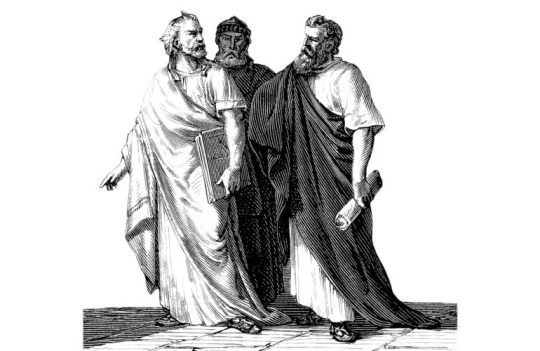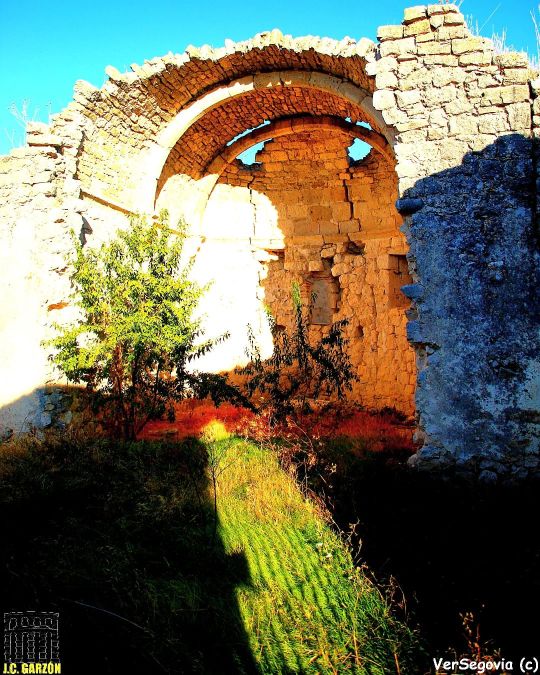#adrados
Text

«Hay en Platón, y aun antes en Sócrates, una reacción que es, en realidad, una restauración del mundo de valores fijos tradicionales, liberado de sus elementos de contaminación. De ahí la oposición cerrada a los sofistas. Pero esa restauración se funda precisamente en el mismo instrumento que los sofistas utilizaban, la razón.»
Francisco Rodríguez Adrados: Palabras e ideas. Ediciones Clásicas, pág. 226. Madrid, 1992
TGO
@bocadosdefilosofia
#adrados#francisco rodríguez adrados#palabras e ideas#la ética griega desde sus comienzos a su elaboración por los sofistas y platón#platón#sofistas#razón#fundamento#cultura griega#filosofía griega#época antigua#sofistica#sofista#tradición#restauración#valores#valores morales#ética#teo gómez otero
2 notes
·
View notes
Text
Tarot Barato Tirada En Cruz, tarot amor y trabajo
Trabajo en categorías: cartas del tarot, runas. Hablo técnicas antiguas. Responderé preguntas que puedan resolver su problema. He estado practicando en esta dirección durante más de 25 años.
Tarot Y Videncia:
LLAMADAS ESPAÑA
🇪🇸: +34 932 995 463 - 806 556 213
LLAMADAS INTERNACIONALES
🇺🇸 Estados Unidos: +1 21 37 84 79 82
🇲🇽 MEXICO: +52 55 84 21 13 51
🇦🇷 ARGENTINA: +54 11 59 84 40 88
🇨🇴 COLOMBIA: +57 15 08 73 39
¿Luchas por seguir adelante? Obtén respuestas instantáneas con una Lectura de Tarot.

0 notes
Text
‘La Sociedad de la Nieve': Una Desgarradora Hazaña
La película seleccionada por España para representarlos en los Premios Oscar ha llegado a Netflix, desde el 4 de enero 'La Sociedad de la Nieve' no ha hecho más que romper récords en la plataforma, desde su estreno hasta el día de hoy se ha mantenido en el Top 1 de lo más visto, y no es para menos, por eso ahora te invitamos a descubrir todo lo que hace tan genial, única y me atrevo a decir histórica a esta película.

View On WordPress
#Agustín Pardella#Bernat Vilaplana#Chile#Cine Español#Diego Vegezzi#Enzo Vogrincic#España#Esteban Bigliardi#Fernando Contigiani#J.A. Bayona#Jaime Marqués#Jorge Adrados#La Sociedad de la Nieve#latinoamérica#Los Andes#Marc Orts#Matías Recalt#Michael Giacchino#Nicolás Casariego#Oriol Tarragó#Pablo Vierci#Sociedad de la Nieve
3 notes
·
View notes
Text


Adrados
5 notes
·
View notes
Text

@properbastard where’s your reply to our adrados thread bitch
#;ooc#(i can bully you for one more day in person)#(you may be quarantined on the top loft bedroom but i WILL bully you over tumblr)
4 notes
·
View notes
Text
“The sanctuary of Eileithyia at Amnissos, known from numerous later literary sources, is the sole case of a sanctuary that is considered to have been identified in excavation and is attested by the Knossian tablets. The frequent reference to Amnissos in the administrative records of the early LM IIIA:2 period is perhaps due to the particular importance of the coastal site as one of the two harbors of Knossos (Davaras and Masson 1983, 383–384; Schäfer 1991, 111–112). The first line of the leaf-shaped tablet Gg(3) 705 from the West Wing of the palace of Knossos records the dispatch of an amphora of honey to Amnissos for e-re-u-ti-ja. This name is transcribed into alphabetic Greek as Eleuthia/Ἐλευθίᾱ, and she has been identified as the goddess of childbirth Eileithyia, known from Homer and many other ancient authors and scholars (Ventris and Chadwick 1956, 310; Aura Jorro and Adrados 1985, 244). . . . Concerning the etymology of the early type Eleuthia, various interpretations have been proposed, the most probable reducing it to an Indo-European root meaning “free of weight,” and possibly referring to the goddess’s role as midwife (Ruipérez and Melena 1996, 187). According to another viewpoint, it derives from the root eleuth- of the verbal type eleusomai (to come, to arrive), while arguments that the name is of pre-Hellenic provenance have also been formulated (Frisk 1960, 456; Schäfer, ed., 1992, 84).
The reference in Homer’s Odyssey (19.188–190) to the cave where the goddess was worshipped at Amnissos echoes the fame of the cult practiced there at least during the Late Minoan period. The initial association of the cave found at Amnissos by I. Hazzidakis in 1885 with Eileithyia was based on this particular passage in Homer (Marinatos 1929, 95). The excavations conducted subsequently by S. Marinatos between 1929 and 1938 confirmed the use of the cave from Neolithic into Late Minoan times, as well as during the Geometric, Hellenistic, and early Roman Imperial periods (Marinatos 1929, 97, 99, 103; 1930; Betancourt and Marinatos 2000). During historical times “mogostokos” Eileithyia, that is, the goddess who brought the pangs of childbirth, was worshipped all over Greece and was identified by various variations of her name in the local dialects: Eleuthyia in Crete, Eleuthia or Eleusia in Laconia, and Eleuthie in Ionia (Frisk 1960, 455). She was particularly popular, however, in many cities of Crete, including Lato, Inatos, Aptera, and Amnissos (Nosch 2009, 27). Although it has been maintained that during the first millennium b.c. a fusing of Eileithyia with Artemis took place (Antoniou 1980, 228–229), it is noteworthy that both deities are recorded independently in the Linear B tablets from Knossos and from Pylos, respectively. The question of the continuity of worship in the Amnissos Cave remains open (Schäfer, ed., 1992, 84); nevertheless, the reference in the Knossian documents to the sanctuary of the goddess advocates the origin of the late cult of Eileithyia from an earlier Minoan goddess of childbirth (Nilsson 1949, 30; Willetts 1962, 168–172).
The brief text incised on the Knossian tablet Gg(3) 705 by Scribe 140, from the Chamber of the Jewel Fresco (Olivier 1967, 85) provides a pretext for certain hypotheses relating to the nature of worship at the site. Honey played an important role in cult, as indicated by the large number of Knossian tablets recording this item. The quantity of honey offered is stated in tablet Gg(3) 705 by the logogram *209VAS, denoting a fixed unit, the precise capacity of which is not known (Ruipérez and Melena 1996, 187). Nonetheless, the attribution of a corresponding quantity “to all the gods” (pa-si te-o-i), in the second line of the tablet, allows us to assume that Eileithyia was the principal deity of Amnissos. Recorded in the third line also is an amphora of honey, which is offered to another deity, whose name is only preserved fragmentarily. Proposed is the restoration of the dative case e-ne-si-da-jo-ne of the possible name of a male divinity, Ένεσιδάhων (Enesidahon; Aura Jorro and Adrados 1985, 219), who is associated with Amnissos in tablet KN M 719 by the same scribe, from the same space. According to some researchers, this is an epithet qualifying Poseidon (Jorro and Adrados 1985, 219). . . .
Tablets KN Od(2) 714.b and Od(2) 715.a, by the specialist Scribe 103 from the Chamber of the Jewel Fresco (Olivier 1967, 44–50, 131–132), concern one other aspect of the economics of worship. Eileithyia receives from the Knossian bureaucrats one intact unit of wool, which is equivalent to 30 kilos of the product, while in tablet Od(2) 716.a she perhaps receives an additional four units of wool. The destination of these offerings is not stated, but it is perhaps related to craft-industrial activity, since the names a-*65-na and ta-wa-ko-to, recorded in these registers, are of persons in a weaving workshop (Enegren 2008, 98, 173). By analogy with the sources of historical times (Soph. OC, 461–493) regarding the dedication of offerings to the gods, it has been proposed that the wool was perhaps intended for the adornment with garlands of the amphorae of honey (Weilhartner 2005, 45).7.”
- Georgia Flouda, The Goddess Eileithyia in the Knossian Linear B Tablets
2 notes
·
View notes
Note
Sure, I have interest :)
GREAT THANKS!!
okay so basically! i found a great book that i originally intended to use to get a few facts about sappho, but it ended up helping me draw parallelisms between ancient greeks' culture around love and the way the characters in olmedo's knight behave. the book by rodriguez adrados im using more or less says for the greeks, love usually happened by first sight and the lover's beauty was often the reason why the person fell in love. he also says there's no "process" in falling in love: it happens instantly. this is true for don Alonso and Inés, because they saw each other and immediately wanted to get married, there was no courtship or anything.
my next step is lacing this with dagenais' article where he says in lope de vega, love isna sickness that manifests through the imagination, which is a key component in the production of poetry. imagination can be like self harm in a way (this is now my theory), because for the person in love, it means they're constantly tormenting themselves with what ifs and beating themselves down when their illusions don't come to fruition. now i gotta analyze how this happens in olmedo's knight and afterwards compare passages of the story with the contemporary songs i've chosen. ☺️
0 notes
Text
"En un lugar de la Panza"
Participación de Eva Ortiz Aguado en el programa de radio Marca sobre gastronomía y literatura el 19 de mayo del 2023, en conversación con el quesero Rubén Valbuena (Cantagrullas) y el sumiller Sergio Muñoz (Proyecto Adrados).
0 notes
Photo

en Adrados, Spain https://www.instagram.com/p/CkWr-dKjXvJ/?igshid=NGJjMDIxMWI=
0 notes
Text
highlights dell'intervista di berna su d4zn
''zero sbatti come si dice a milano. a carrara come si dice?'' ''..........non si può dire''
la sua bimba è superdolcina mamma mia 🥺
"qua vige una regola: le donne comandano. a casa mia è così"
BERNA E LA PASSIONE PER LE LIQUERIZIE PASSATA DALLA MAMMA
"fede tu fai la cacio e pepe" "non io..........................noi"

il suo cerottino rosa al dito
LA SUA BIMBA LO CHIAMA BABA PERCHE' DA PICCOLISSIMA NON RIUSCIVA A DIRE BABBO SONO IN LACRIME
quasi prendeva in faccia dilettona palleggiando con un'arancia lo amo
berna che cucina la cacio e pepe like a pro
ha raccontato che a 16 anni gli si è fermato il cuore e non ha potuto fare attività fisica per 6 mesi???? wtf
il suo film preferito è se7en rip
HA FATTO UN MEZZO BALLETTO DI C*ADRADO STO MALE
lui è proprio una fatina con la sua vocina dolcissima io lo amo troppo 🥺🥺
#non so come registrarvela pals non mi fa neanche prendere screenshots??? d4zn 🔪🔪🔪🔪#federico bernardeschi
39 notes
·
View notes
Text

«Los sofistas no atentan contra la idea del Estado ni contra la democracia; más bien ayudan a la juventud a servir a ese Estado y esa democracia. Pero ello a través de los individuos, dándoles una formación racional y no ya puramente tradicional. Si Esquilo había hablado de una conciliación de clases y poderes al servicio de la comunidad, ahora la sofistica cree poder desarrollar la areté o virtud política de los ciudadanos al servicio de esa misma comunidad, explicándoles las normas según las cuales funciona y ayudándoles a lograr ese poder de persuasión, ese acierto en la decisión de que hablaba Esquilo. Pero ello ya por vía racional. La misma democracia será fundada racionalmente. Y este empleo de la razón implica la posibilidad de perfección, creando nuevas individualidades capaces de lograr por persuasión el mando y la dirección de la ciudad y de sustituir a los hombres que lo detentan por una herencia familiar y con ayuda de una formación puramente tradicional.»
Francisco Rodríguez Adrados: Ilustración y política en la Grecia clásica. Revista de Occidente, págs. 204-205. Madrid, 1966
TGO
@bocadosdefilosofia
@dies-irae-1
#francisco rodríguez adrados#rodríguez adrados#adrados#ilustración y política en la grecia clásica#ilustración#política#democracia#sofistas#sofística#dirección#estado#gobierno#virtud#virtud política#areté#persuasión#esquilo#razón#tradición#fundamento racional#mando#poder#poder político#antigua grecia#filosofía griega#época antigua#teo gómez otero#partenón
2 notes
·
View notes
Text
PARA TI (PROSA); 24/10/2021, 09:00 PM
Estoy profundamente enamorado de ti, bajo la lluvia, entre el vendaval y los raudales, crece sobre la copa de una rosa, la estridente margen irresuelta que cabe entre mis brazos tu mirada, el rencor que llevo tras tu partida. Las luces diurnas, el alba vespertina y la súbita muerte que engendra la falacia que llevo esperándote. Hordas de céfiros y trinos, imagen portentosa del nicho que converges, la tardía oscura en la que ruinan las voces: eres la flama estrellada que incendia los bosques y las selvas, que crece entre la chimenea y cuida de mi hogar. Las aves se enredan entre los arces y los cipreses, se encaraman hacia el suelo en un abismo irreprensible. Las siluetas de dorada índole, parecieran hipérboles de ensueño adrado y contienen en su sustancia aquella imaginación maravillosa en la que reinan tu busto y el horizonte escondido. Sobre las migas y las aceras, sobre el portón y las balaustras, entre el rincón y la hendija que atavía, irgue una cusa indecible que insomne componga tu estadía en mi corazón; eres la mujer más hermosa que haya Existido.
#poesía#poema#prosa#escrito#escribir#texto#amor#desamor#poetry#prose#written#write#text#love#heartbreak#Eücrí de Moré
4 notes
·
View notes
Note
I'd like to hear your Etruscan as para IE thoughts
Not well developed yet, and I should learn more about Anatolian first, but there are suggestive morphological correspondences, just like with Indo-Uralic. Previous attempts to connect Etruscan to IE propose that Etruscan is an Anatolian language, which does not seem plausible to me.
Adrados lists some morphological correspondences, but he thinks it’s Anatolian.
Forni has a better-formatted list, including:
Genitive in -al ~ PIE *-(o)lo-, cf. Anatolian patronymics in -al and the Lydian lateral possessives
Genitive in -s ~ PIE *-s
Locative in -i ~ PIE *-i
Pronominal accusative in -n ~ PIE *-m (which independently shifted to -n many times in the branches)
Feminine marker in proper nouns -i ~ PIE *-ih2 (is anything like this attested at all in Anatolian...?)
Denominative adjective in -na ~ PIE *-no-
θi ~ ti ‘in’ (later a locative ending) ~ PIE *-dʰi / *dʰe (maybe also absent from Anatolian?)
1SG mi
And more plausible candidates for lexical cognates than Indo-Uralic. Some of Forni’s are obvious loans (cap- ‘take’) or ridiculous methodological malpractice (nursery words), but:
clan ‘son’ ~ *kelH-n- > Gk kélōr ‘descendant, son’
ica ‘this’ ~ *h1(e)y-ḱo- > Gk ekeî (< *h1e-ḱe-i), Oscan ek(ú/a)- (surely Etruscan wouldn’t loan a demonstrative from Italic, right?)
ita ‘this’ ~ *h1(e)y-to- (then he repeats the same etymology for et ‘thus’...)
-c ~ -χ ~ -ca ‘and’ ~ *-kʷe
cel ‘earth’ ~ *kʷel(h1) > Lydian qela- ‘land, estate’
etera ‘member of a lower class’ ~ *n̥dʰero- ‘lower’ > Lycian ẽtre- ‘lower’ (seems like this can’t be an Italic loan - cf. Lat īnferus)
lautni ‘freedman’ ~ *h1leudʰ- is attractive but Forni doesn’t list any Anatolian cognates
Others are more difficult:
tiu ‘moon, month’ ~ *dey-... but Wiktionary says *deyn-o- ‘day’ was a backformation from *deywos, derived as *deyw-os- from metathesis of *dyew-... but I don’t know that I buy that. Is there any reason not to reconstruct *dey- and *dyew- as two separate roots? I think we’d want *dyew here.
puia ‘wife’ ~ *potnih2 - requires a development of *-ih2 (are we sure this isn’t anachronistic?) like the one in Greek and Tocharian, which seems unlikely, and why would *-n- disappear even before *-y-?
nefts ‘grandson, nephew’ ~ *nepōt-, which Forni says can’t be an Italic loan because Lemnian naφoθ, but then where does the -s come from?
en ~ ein ‘not’ ~ *ne / *n̥
ar- ‘to make, do’ ~ *h2er-, but tarχun < *terh2-u- - what’s going on with the laryngeals?
It’s definitely not secure, and I don’t think many of Forni’s proposed etymologies would survive serious scrutiny, but how much worse is it than Indo-Uralic, which everyone secretly believes?
5 notes
·
View notes
Text



Adrados, Diarado & Pría!
15 notes
·
View notes
Text

ITS 1AM AND IM CRYING OVER A STUPID TERESA/SHARPE MUSIC VIDEO AND TERESA IS ALIVE AND OKAY, SHE’S FINE!!!!!!!!!!!!!!!!! I DONT CARE WHAT ANYONE SAYS SHES ALIVE AND WITH HER FAMILY AND HAS A GOOD LONG LIFE i lovE HER!!!!!!!
#;ooc#(i KNEW I WOULD CRY AS SOON AS I CLICKED ON THE MUSIC VIDEO)#(I NEED ME SOME ADRADOS THREADS STAT)#(I LOVE MY POST SURGERY THREADS)
4 notes
·
View notes
Photo


Ilustración para revista / Magazine illustration
El Notario del siglo XXI (nº74)
Defensa de la competencia
Antonio Rodríguez Adrados
__
sígueme en: / follow me:
I. Mouronte B. en Facebook & I. Mouronte B en Twitter
#magazine illustration#Illustration#antitrust#monopolio#competencia#portrait#retrato#Rodríguez Adrados#magazineillustration
1 note
·
View note